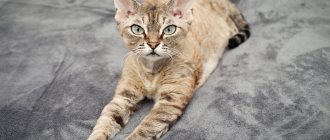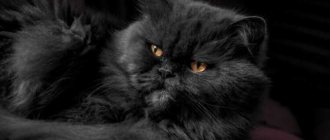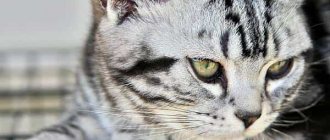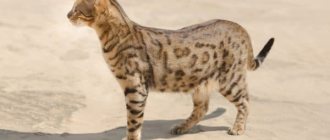History of the breed
The first exotic cat appeared due to a spontaneous combination of genes.
In an effort to achieve new features of appearance, they were crossed with the American Shorthair and Persian breeds. The goal was the desire to obtain a special physique. The resulting offspring received many traits from Persian cats, namely their doll-like face. In 1966, Jane Martink showed the world a new breed, which was called the Exotic Shorthair. These animals took a long time to achieve their official recognition. were skeptical about it, considering them an encroachment on the purity of the breed. However, there were those who were able to see the prospects of new cats, they took part in its formation and spread. Two of them are especially worth noting: Doris Walkinstick and Caroline Bussey. They put a lot of work and effort into this work. Burmese cats and the Russian Blue breed also took part in the selection. The experiments ended when short-haired offspring were obtained. This feature was successfully fixed in the genome of animals. At this time, this breed can only be crossed with Persian cats. In 1990, felinologists adopted a standard that completely replicates the requirements for “Persians”, except for some characteristics - body length, coat characteristics. All changes that are made to the standards of Persian cats are also relevant for exotics. The exotic shorthair cat has similar appearance characteristics to the Persians.
Appearance
In all respects, except for the length of the coat, exotics are similar to Persians. They have a large round head, large round eyes, a short nose, full cheeks and small ears with rounded tips. The neck is thick and short, the body is strong and muscular. Exotic paws are short, thick and strong. The tail is short, but proportional to the length of the cat's body.
A soft, thick, plush medium-length coat with a rich, dense undercoat complements the appearance of an exotic cat.
Exotics come in different “appearances” - the color can be “extreme” and traditional. “Extreme” cats, which are often seen at shows, have a flatter face, which can be accompanied by breathing problems. Traditional-looking cats have a less flat face and a nose that sits lower, allowing them to breathe easier.
Exotic cats of all stripes come in an endless variety of coat colors and patterns. They can be white, blue, black, cream, chocolate, silver and gold. There are also combinations of shades and patterns - each exotic is unique.
Eye color is associated with coat color. For example, white exotics have dark blue or shiny copper eyes. Heterochromia is also possible - one copper and one blue. Silver and gold cats have green or blue-green eyes; and so on.
Character of an exotic cat
The main qualities of an exotic cat are friendliness, moderate playfulness, and curiosity. They have proven themselves well in large families, but have many positive reviews from single people. They quickly and strongly become attached to their owner, but are not particularly intrusive. The pet will calmly wait for its person to come home from work, and then sit comfortably on his lap.
Question to the expert
Is it easy for exotic kittens to get used to their new home?
Exotic kittens have good adaptive skills. They quickly get used to new conditions and do not experience much stress. The main thing is that he gets to know his surroundings.
They have the ability to react sensitively to a person’s mood. If he has difficulties at work, the pet will make every attempt to calm and comfort his owner. These cats are playful and active.
They enjoy running and catching balls or imaginary prey, exercising their hunter instincts. The most popular activity for them can be called catching their own tail. You can safely leave children with these animals without fear of consequences, but with strangers, they are cautious and wary.
Interesting read: all the information about British cats.
Psychology
Exotics have a calm disposition, although young individuals occasionally run “races” around the house, flexing their powerful muscles.
In addition, Snoopy is silent; they rarely give voice, only when they really need something.
Exotics are selective in their affections and at first look closely at their owner.
However, if you manage to find a rapport with the plush charm, you will receive almost dog-like affection.
An exotic cat needs communication and becomes attached to a specific person.
You can read about other sociable cat breeds here:
This may cause some inconvenience if you need to leave your pet - exotic cats, unlike Scottish Straights or Scottish Folds , feel sad when separated.
But they can handle any type of transport well and travel willingly.
If you already have other pets - cats or dogs - in your house, the conflict-free Snoopy will become an excellent companion cat for them.
Yes, yes, the exotic cat can read. You can discuss a book you recently read with him. True, he will keep his opinion to himself
Education and training
Raising or training this cat is quite easy. These are smart animals that respect their owner, observing the rules of behavior established by him. They quickly get used to the tray and are not inclined to misbehave, especially if their upbringing began in childhood.
With enough attention and time, they can be taught simple tricks and commands. This requires patience. If the animal fulfills the command correctly, it must be rewarded. Rudeness or physical force can destroy the trust between a person and an animal.
Shorthair exotic.
Basics of a healthy diet
Breeders usually use premium ready-made food for feeding. They already have a balanced composition, all the necessary substances - vitamins, minerals, proteins, normal fat content. Exotic kittens quickly get used to a certain diet; any changes in it can lead to problems with the digestive system. It is convenient to monitor proper weight gain using a table of exotic weights by month in the first 2 years of life.
Table of weight of exotic kittens in the first 2 years of life.
These cats have a good appetite, which means they have a high risk of gaining excess weight if they are not properly active. The food portion is 150 grams of food per day, for a girl – 130-140 grams. Food should be given 2-3 times a day, small kittens are fed more often - 4-5 times.
Long-haired exotic cat.
How to organize natural nutrition
An exotic cat, as natural food, should have a diet consisting of:
- rabbit, veal, chicken, turkey;
- fermented milk products – kefir, yogurt, fermented baked milk;
- oatmeal and rice porridge cooked in water;
- low-fat cheese.
Prohibited foods for them are: whole milk, fatty meat, potatoes, any bones, especially small fish.
Natural habitat
Photo: Chermundy
Marbled cats are found in Nepal, northern India and throughout Southeast Asia, from the southern Himalayan foothills to Malaysia, Borneo and Sumatra. Although they have a relatively wide geographic distribution, their range is highly fragmented.
In the wild, the marbled cat was first photographed in Thailand's Hua Khakhaeng Nature Reserve in 1994, as the use of camera traps in the field became more common.
These wild cats are found primarily in moist and mixed deciduous-evergreen tropical forests . They seem to prefer remote, dense virgin forests. Marbled cats live in areas further from the forest edge and at moderate altitudes. Although they have also occasionally been observed in secondary forests, cleared areas and agricultural plantations. However, they avoid highly disturbed human-dominated habitat types.
In Nepal, marbled cats were recorded at an altitude of 2750 meters, and in Bhutan's Jigme Dorji National Park - at an altitude of 3810 meters.
- Biogeographic regions: eastern
- Climate zones: tropical
- Terrestrial biomes: woodlands, shrub forests
Health and disease of the breed
The exotic Persian cat has inherited a number of diseases to which Persians are predisposed.
One of the most common problems is problems with the eyes, namely increased levels of tearfulness. The nasolacrimal duct is shorter in exotics than in other cat breeds. It is necessary to remove these contaminants every day; if this procedure is not carried out, there is a risk of conjunctivitis.
They often suffer from colds, gum inflammation, and kidney problems. Anatomically, they have a curved lower jaw, which makes it difficult for them to eat. From their Persian relatives, exotics acquired a tendency to certain diseases.
Polycystic kidney disease develops with a probability of up to 80% if this disease was diagnosed in one of the kitten's parents. Another disease characteristic of the breed is cardiomyopathy. With this pathology of the heart, the left ventricle suffers. Symptoms of the development of the disease are:
- frequent shortness of breath;
- pallor of mucous membranes;
- fatigue.
Exotic kittens may not show any signs of these diseases at an early age. The lifespan of this breed is on average 13-14 years, but there are individuals that live up to the age of 18 years.
How to choose a kitten
Exotic kittens endear you from the very first visit to a breeder or nursery. Little exotics resemble a beautiful plush toy. When choosing, you need to pay attention to the pedigree and parents, the state of his health. It is recommended to choose a reliable nursery that has many positive reviews, recommendations, and many years of experience working with the breed. Often, unscrupulous sellers, under the guise of exotics, offer British dogs with an admixture of the Persian breed. But mixed-breed kittens should cost less. There are different crosses of exotics:
- American exotic;
- exotic extreme;
- lop-eared exotic.
Crossing exotics with third-party breeds is prohibited, and buying such a kitten for the purpose of breeding threatens poor health and future offspring not meeting recognized standards.
How much does an exotic cat cost?
The exotic breed belongs to the middle price segment. The cost of kittens ranges from 15,000 to 70,000 rubles. Pricing is influenced by:
- pedigree;
- parents' title;
- the kitten belongs to a certain class.
The most expensive is the show class. Such cats do not have any appearance flaws. Pet class animals cannot take part in breeding work and are subject to mandatory sterilization. But this does not affect their character, loyalty and love for their owner. An exotic kitten of this class costs up to 7,000 rubles.
Interesting read: everything about the character and habits of Maine Coons.
Nicknames for exotic cats
A kitten of any breed should have a beautiful, understandable, but memorable nickname that will fully characterize it. The most common variants of nicknames for exotics are the following:
Table of popular names for cats and cats.
Save Status
"Near Threatened" on the IUCN Red List . However, its conservation status and distribution are poorly understood, and the size of the global marbled cat population has not been quantified. There are likely just over 10,000 adults in the wild. There are some indications that this species may be relatively rare compared to other felids in the same habitat.
The main threats to the marbled cat and its prey are:
- deforestation. Southeast Asia has one of the highest and fastest rates of deforestation, mainly due to logging and forest conversion for human settlements, agriculture, oil palm plantations, coffee, rubber and other crops;
- hunting for meat and fur, as well as bones and other body parts used in traditional Asian medicine and rituals;
- accidentally falling into a snare.
The marbled cat is listed on Appendix I of CITES and is protected in part of its range. Hunting is prohibited in Bangladesh, India, Indonesia, Cambodia, Malaysia, Thailand, Myanmar, Nepal and Yunnan Province of China. Hunting is regulated in the Lao People's Democratic Republic and Singapore.
Breeding Features
To breed this breed, you must have all the necessary documents for this - pedigree, belong to specialized clubs, have breeder documents. The goal is to improve the characteristics and appearance of the breed. Mating can be carried out with exotics and Persians themselves. The cat must meet all standards.
Castration and sterilization
Exotic cats need to be sterilized if they do not meet the breeding criteria of this breed, that is, they belong to the pet class or have signs of disqualification according to the system of recognized standards. This procedure is carried out in the same way as in other breeds, by a veterinarian at the age of 6-8 months. The optimal age for sterilization is selected by a specialist.
Appearance care
Exotic shorthairs do not require complex care, but there are some peculiarities.
Brushing and bathing
Exotics are recommended to be bathed approximately once every two to four months. To wash the thick undercoat, you should use specialized shampoos, which can be purchased at veterinary pharmacies or a pet store. You cannot use shampoos intended for humans, soaps and household chemicals, as the animal may have an allergic reaction.
To add shine to the coat, experts advise rubbing the hair with a suede cloth. Since exotic shorthairs have a flattened muzzle, pets often get their chin dirty while eating, so it is necessary to periodically wipe the contaminated areas with a napkin. Animals are combed once a month with a special brush.
Eye care
The eyes are a weak point for exotics. This breed of cat often suffers from inflammatory diseases of the conjunctiva and other pathologies, so hygiene procedures should be carried out regularly. Wash your eyes using a specialized product. After the procedure, the hair is dried and powder is applied using a cotton pad or swab. This product contains an antibacterial compound that helps prevent infectious eye diseases that exotics are susceptible to.
Ear care
To keep your ears healthy, it is recommended to perform hygiene procedures once a week. Using a special antiseptic applied to a cotton pad or gauze, wipe the inner surface of the ears. At the end of the manipulation, you can use antibacterial powder.
Nail trimming
The procedure is performed as the claws grow - approximately once every two to three weeks. Do not use regular scissors, as they may damage the soft tissue of your fingers. For manipulation, you should purchase special nail clippers.
Oral care
Prevention of dental diseases involves caring for your pet’s oral cavity. You should brush your teeth at least once every 7-10 days using a special brush. If plaque appears, you should contact your veterinarian.











